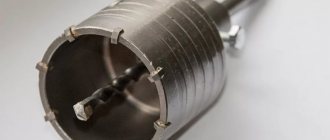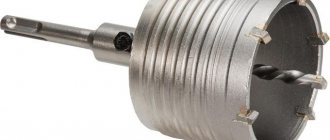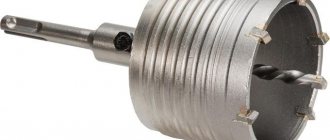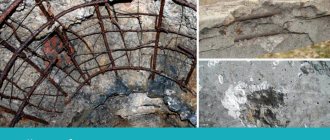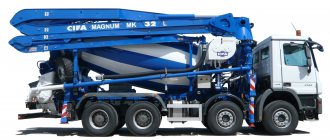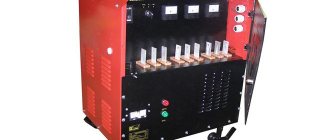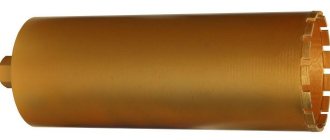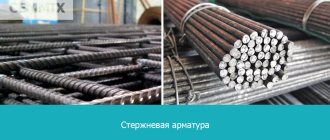Beton-House.com
Website about concrete: construction, characteristics, design. We combine the experience of professionals and private craftsmen in one place
Crowns of different diameters for drilling concrete
Tools with a cavity inside are used for drilling holes and drilling through concrete of any strength. They allow you to make technological holes of different diameters.
Concrete drill bits can be used to prepare sites for mounting sockets and switches. The article introduces what types of tools there are, how to choose them, the principle of operation and the most popular manufacturers.
- Tool selection criteria
Features of using crowns
- Model range of crowns
Review and description of the main types of crowns
To effectively cut holes in, it is important to choose the right bit based on the material in which the drilling will be carried out.
Depending on this, the type of crown is selected, which is determined by the type of cutting attachment. For concrete, stone and brick partitions, the following edges are used:
- Diamond.
- Tungsten carbide.
- Pobeditovye.
Let's talk in detail about each type.
Diamond
The peculiarity of this tool lies in the technology of non-impact drilling. With this method, a more correct hole geometry is obtained than when cutting with a carbide-tipped tool.
Holes drilled with a diamond bit (A) and a carbide bit (B)
There are two concrete drilling technologies: “wet” and “dry”. Accordingly, different types of crowns are used for each of them.
Wet cutting tool.
In such crowns, the cutting part consists of diamond tips soldered to the base with refractory solder. If cooling water is not supplied to the edge during the cutting process, the nozzle will quickly heat up to a threshold temperature (about 600°C), after which the tool will fail.
Wet cutting bits Hilti Diamond Core
A crown of this type that has become unusable can be restored, despite the fact that this is an expensive process, its cost will be lower than the price of a new instrument.
Dry cutting tool.
When making crowns that do not require forced cooling, the cutting attachments are welded to the base using a laser. Such a tool may be subject to a higher thermal load, but, unfortunately, if it fails, it cannot be repaired.
Rubi Foragres bits for dry cutting of concrete
Advantages and disadvantages of diamond-coated hole cutters.
Let's start with the undoubted advantages:
- Such a tool can even cope with reinforced concrete, that is, it can cut steel reinforcement.
- Low noise level and no dust (during wet cutting).
- The structure of the structure is not damaged, since the shockless method is used.
- It is possible to restore the cutting surface (for wet cutting tools).
The main disadvantage of diamond bits is their high cost, which can be offset by the possibility of restoring the tool. But this is only available for wet hole saws. To work with such crowns, a special drilling tool is required, which does not make sense to buy for the sake of drilling a dozen or two holes. This is a professional level technique.
“Dry” crowns can be used with a conventional hammer drill in a non-impact operating mode. But this requires a certain skill, the tool is quite fragile, if vibration occurs (for example, when the support drill is rotated), the cutting attachments may break off. Such a crown cannot be restored.
Tungsten carbide
This type of cutting coating allows you to work with brick, concrete and ceramic materials (for example, tiles). If such a cutter encounters metal fragments, it almost always fails, that is, such a tool is not suitable for cutting reinforced concrete.
Tungsten carbide coated bit
Pobeditovye
This is the most common type of hole saw. Its main feature is that teeth made of pobedite or other hard alloy are used as the cutting material.
Core cutter with carbide inserts and SDS shank
For this type of tool, a percussion drilling method is provided, that is, it is intended for use in conjunction with rotary hammers. Accordingly, the shank of such bits is made for an SDS chuck (SDS+ and SDSMAX options are possible).
The main advantage of such a drill is its low cost. As for the disadvantages, these include:
- Rapid tool wear.
- Impossibility of restoring cutting attachments.
- Failure upon contact with metal fragments (reinforcement).
Despite a large number of disadvantages, tools with carbide tips remain in demand due to their low cost.
Popular crown models
Crowns are produced by quite a few Russian, American and European manufacturers. Products (USA) are considered one of the most popular.
Including the manufacturer’s crowns are widespread in Russia. Tooling with a diameter of up to 80 mm is produced, including for processing reinforced concrete products.
Crowns “Diamond Diamond”
Diam Almaz is a domestic manufacturer that produces several types of crowns:
- Grade G. Optimal for processing concrete of the M100-M300 series.
- Grade S. For concrete grades M400-M600.
- Brand TOP. Suitable for processing concrete of increased hardness.
Bosh crowns
The German company produces crowns of various types and sizes. The equipment is popular due to its high quality, but is more expensive compared to domestic analogues. Products with a diameter of 68 mm are most in demand.
DeWalt crowns
is an American manufacturer of construction tools that produces drilling equipment in all standard sizes. The products are suitable for drilling to a depth of up to 80 mm. The instruments belong to the middle price category.
The most popular are 68 mm bits with a diamond-coated cutting part.
Crowns "Distar"
Ukrainian manufacturer of construction equipment. Offers inexpensive products of fairly high quality.
The most popular are diamond-coated crowns.
- The manufacturer offers diamond tools with diameters of 68, 72 and 82 mm.
- The tools have a fairly long service life and provide fast drilling.
There are models for both wet and dry drilling. The products have a special design for more efficient disposal of cuttings during the drilling process.
The range includes not only equipment for concrete and reinforced concrete, but also other hard materials - ceramics, cermets, granite and marble.
Recommendations for use
Requirements for safety and comfort when installing sockets and switches:
- Electrical sockets must be installed at a distance of at least 250÷300 mm from the floor or table surface (if installed in the kitchen).
- The distance from the corner or edge of the wall should be at least 150÷200 mm.
- The most comfortable location for switches is 900÷1000 mm from the floor surface.
Before purchasing a drill bit, you must carefully measure the available socket boxes. The diameter of the crown should match the diameter of the mounting box (or be slightly larger).
Required tools:
- hammer drill or electric drill;
- hammer or small sledgehammer;
- crown for concrete or brick (depending on the wall material);
- chisel or punch.
On a note! If the crown is intended for concrete walls, then it can easily be used to make a hole in brick. But a crown designed for brick costs much less, so you should not overpay if you are carrying out electrical work in a brick house.
Watch the video for details:
Work order:
- Using a detector to search for reinforcement, we determine the location of metal rods in the wall and the thickness of the concrete layer above them. If the layer of concrete above the rods exceeds the mounting depth of the socket box, then you can begin marking future holes without taking into account the reinforcement of the walls. If the reinforcing bars are close to the surface of the wall, then you need to mark their locations with a marker, and only then begin marking future holes for installing mounting boxes.
- Taking into account the recommendations for installing sockets and light switches, mark the holes on the wall using a ruler, level and marker (or pencil).
- We install the crown into the hammer drill.
- We make a circular cut in the wall.
Attention! When using carbide bits, it is necessary to take short technological breaks to prevent overheating of the cutting elements
- Using a hammer and chisel (or a flat drill inserted into a hammer drill), we free the inside of the mounting hole from concrete (or brick).
- We insert the electrical wires into the socket box hole.
- Using a quick-hardening solution, we fix the socket box in the hole.
- After installing all the necessary socket boxes, you can begin installing sockets and switches.
Design and types of crowns for concrete
Externally, the socket crown looks like a piece of steel pipe with holes in the wall to allow concrete dust and crumbs to escape during operation. One end of the tube is capped with a flange for attaching the bit to a hammer drill chuck with special fixing grooves that comply with the SDS standard. On the other hand, the end of the tube has teeth sharpened around the circumference and a protruding central drill, which fixes the position of the crown in the wall during the drilling process and prevents it from “walking” when rotating. The centering drill can be replaced if it becomes dull or sharpened again.
There are many varieties of these attachments depending on the hardness of the material being processed, the diameters of the holes being drilled and the type of attachment to the chuck. Currently, concrete drill bits are produced in two main modifications - for impact or non-impact drilling. Based on the design and materials used, these nozzles can be divided into the following types:
Toothed crowns for impact drilling.
In them, the cutting edge is formed by separately soldered teeth made of especially strong and hard alloys. They also have SDS type shanks for fastening into keyless chucks of hammer drills. Serrated bits are used with rotary hammers and hand drills. Their disadvantage is the possibility of tooth breakage when encountering iron reinforcement of concrete products. Although the strength of the teeth themselves is high and allows them to cut metal, the impact drilling mode creates unacceptable loads on the solder joints, which leads to their destruction. Therefore, such crowns can be used for drilling holes only in the inter-reinforcement spaces of reinforced concrete slabs or in brick walls.
Diamond bits for hammerless drilling.
They are more technologically advanced attachments and are used with drills and hammer drills in hammerless drilling mode. Such crowns have a smooth abrasive cutting edge with small cutouts, which is formed by spraying fine corundum or diamond sand. The progressive technology of non-impact drilling with a diamond core has a number of advantages compared to the impact method. These include:
- reduced noise level during operation of the tool;
- less dust in the air;
- absence of impact load on the processed material, leading to the formation of cracks on the surface;
- low impact on the tool, ensuring convenience and ease of working with it;
- high quality and precision of the shape of the drilled hole in hard materials.
The crown easily copes with the metal reinforcement of concrete slabs. It has working diameters from 12 to 650 mm and allows you to drill holes up to 1.5 m in depth. Attachments measuring up to 100 mm in diameter can be used with both professional tool models and household drills to perform work without the use of forced cooling. Large diameter bits with brazed diamond segments are used by professional drilling rigs using water cooling and forced removal of waste from the hole using a compressor.
Diamond-coated KS standard crowns
They have protruding segments on the cutting edge, on the working surface of which diamond crystals are embedded. This type of bits successfully replaces carbide gear bits and is used for drilling holes in rocky soil, in slabs and monoliths made from especially strong grades of concrete. It has the longest service life without repair.
Application
Drilling heads are used to cut out voids in the body of reinforced concrete structures for laying communications (pipes, cables), arranging seats for distribution boxes, switches and sockets.
Crowns are used to drill concrete, brick and stone masonry, both rotary and impact-rotary. During excavation, the walls of the holes do not crumble, and the surface of the concrete fences does not become cracked.
Diamond crowns for concrete do not damage the finishing of walls (ceramic tiles, wood, plastic, etc.). When drilling a hole, a cylinder of monolith remains, which is then knocked out with a hammer drill and chisel in impact mode. This is done carefully, keeping the walls of the recess intact.
Depending on the length of the SDS holders, holes with a depth of 50 mm to 1500 mm are drilled in concrete. To create through passages in adjacent fences, counter-drilling is carried out on both sides.
To prevent overheating of the SDS bit for concrete, the massif is sampled by supplying a stream of water to the drilling zone. At home, the head is periodically moistened with water from a garden spray bottle.
Depending on the diameter, core drills are used for laying communications in reinforced concrete structures of a certain cross-section. Thus, 72 mm concrete drill bits are used to install seats for electrical wiring distribution units. Plastic boxes are inserted into the drilled recesses into which the ends of the wires are brought out.
100 mm concrete crowns are used to create openings into which ventilation pipes are led, diverting air flows from boilers and other heating equipment to the outside. They also have pipelines for air intake from outside.
150 mm crowns are most often suitable for laying sewer pipes. They are used to drill both walls and floor slabs, which is convenient for installing drain lines. Core drills of large diameters (300 mm - 800 mm) are used for wiring special communications in structures and industrial buildings.
Photo of diamond bits for concrete
Device Features
The crown is a hollow cylinder, on the edge of which cutting elements are provided on one side. High strength is ensured through the use of polycrystalline diamonds. They form the cutting edge. The nozzle is made of tool steel. The thickness of its walls can be different, as well as the diameter of the product itself.
Diamond core bits for drilling concrete differ in length. The largest products resemble a pipe with a cutting edge at one end, since they are intended for preparing holes in structures of significant thickness.
The diameter varies between 35-130 mm (for domestic use). Larger nozzles are used in industrial facilities. Their diameter can reach 600 mm.
The nozzle is attached using a flange to the hammer drill. The use of a drill further strengthens its fixation. Diamond-coated crowns can be cast or prefabricated (consisting of segments and edges). In addition, there are other types of nozzles:
- KS series;
- serrated.
The first group includes products with polycrystalline diamonds fixed in a matrix. They are used to create holes and grooves in concrete using non-impact technology. In this case there is no vibration. A diamond bit for concrete with an SDS shank and cutting teeth, on the contrary, is used where there are no restrictions on the intensity of the impact force. This nozzle allows you to create holes with a diameter of up to 100 mm.
Shaft-mounted tools should not be used to create holes in reinforced concrete structures. This is often the reason for the failure of the nozzle, since metal elements can become an insurmountable obstacle for soldering. The negative factor in this case is the heterogeneity of materials (iron, concrete).
Scope of application of diamond bits for concrete:
- laying of communications: installation of a ventilation system and air conditioners, water supply, sewerage, installation of heating risers (for laying pipes in interfloor ceilings), wiring;
- fastening of suspended structures of any configuration;
- fixation of stairs (installation of anchors).
If no impact force is required, electric or pneumatic tools may be considered. Higher power units can also be used. This option is advisable to use for working with reinforced concrete structures of large thickness.
Such products create holes in concrete walls due to intense rotation. At the same time, the pressure on the surface of the structure gradually increases. First, grooves are formed, then the nozzle goes deep into the concrete layer. As a result, the tool allows you to obtain a through hole. The quality of the work performed depends not only on the type of nozzle, but also on the material of construction. Thus, diamond bits can also be used for drilling brick walls, foam and aerated concrete.
By rotating the diamond bit, a hole is created in the wall.
How to choose the right one
When choosing a crown for concrete, you need to take into account the type of surface you will be working with: for unreinforced structures, Pobedit bits are suitable; for reinforced concrete, only diamond-coated bits can handle it. You should also pay attention to the following points:
- the diameter must correspond to the specified parameters of the hole, and the length must correspond to its depth;
- if there is a large volume of upcoming work, preference should be given to models with diamond coating;
- It is important that the crown matches the power of the tool used ; the use of large-diameter attachments can lead to failure of low-power equipment;
- the design of the shank must be suitable for the fastening system in the chuck of a drill or hammer drill;
- the higher the number of cutting segments , the better the technical characteristics of the equipment;
- deep seating of the teeth guarantees strong fixation and durability of the crown;
- You should make sure that the nozzle is smooth, has no burrs or defects, and that the spraying is durable, applied in an even layer and does not crumble.
Selecting Tool Sizes
To figure out the size of the product, you need to start from the diameter of the desired hole. A diamond bit for drilling concrete is sold separately or in a set, which already includes all the required sizes. All necessary data is in the passport or indicated on the label.
Standard circumference is 68 mm. Most sockets are manufactured specifically for these parameters. Less common are 70 and 75 mm. However, the diameter comes in: 8, 10, 12, 20, 24 and 32 mm.
It happens that the socket is already on hand, but what hole to make is unclear. Take a caliper and measure the outer circumference of the rosette. The resulting number will be the diameter. The depth available to it depends on the length of the crown. The more cutting teeth (5, 6, 8), the easier the drilling process.
TOP 16 best diamond crowns for socket boxes
| Photo | Name | Rating | Price | |||
| The best diamond crowns for premium socket boxes | ||||||
| #1 | PRACTICE 917-293 162 mm | ⭐ 5 / 5 1 - voice | Find out the price | |||
| #2 | HILTI SPX-L DIAMOND FOR CONCRETE X-CHANGE 82 MM | ⭐ 4.95 / 5 4 - votes | Find out the price | |||
| #3 | Dr. Schulze DS-LB Premium 82 mm | ⭐ 4.9 / 5 6 — votes | Find out the price | |||
| #4 | Crown Messer 06-20-082 82 mm | ⭐ 4.85 / 5 3 - votes | Find out the price | |||
| The best budget diamond drill bits for socket boxes | ||||||
| #1 | Wolverine 500068 68mm | ⭐ 5 / 5 1 - voice | Find out the price | |||
| #2 | Bison29865-73 73 mm | ⭐ 4.95 / 5 5 — votes | Find out the price | |||
| #3 | d28 KURS | ⭐ 4.9 / 5 | Find out the price | |||
| #4 | HRD150 42x150 mm, M16 Niborit v1007 | ⭐ 4.85 / 5 1 - voice | Find out the price | |||
| The best diamond bits for socket boxes in terms of performance | ||||||
| #1 | Diamond bit (102/150 mm M16) KEOS DC102.150 | ⭐ 5 / 5 1 - voice | Find out the price | |||
| #2 | Crown (68/70 mm M16) KEOS DC068.70 | ⭐ 4.95 / 5 7 — votes | Find out the price | |||
| #3 | New Formula 68 mm TRIO-DIAMOND NF068 | ⭐ 4.9 / 5 6 — votes | Find out the price | |||
| #4 | Diamond bit for concrete Hilberg Laser (68 mm) TRIO-DIAMOND | ⭐ 4.85 / 5 4 - votes | Find out the price | |||
| #5 | Diamond bit for concrete (80 mm) TRIO-DIAMOND GC788 | ⭐ 4.8 / 5 2 - votes | Find out the price | |||
| #6 | DIAM 311103 M16-SDS+ (82x70 mm) | ⭐ 4.75 / 5 5 — votes | Find out the price | |||
| #7 | Diamond bit for concrete (68x70 mm M16/HEX12) Diam 311116 | ⭐ 4.7 / 5 4 - votes | Find out the price | |||
| #8 | Diamond bit (68 mm SDSplus/M16) Enkor 48280 | ⭐ 4.65 / 5 3 - votes | Find out the price | |||
Which crown would you choose or recommend for drilling socket boxes?
Take the survey
Advantages and disadvantages of crowns for concrete
The drill bit has a number of advantages. With the correct selection, a hole of the required diameter is obtained quickly. Another advantage is the acceptable noise level during operation. But this tool is still not widespread enough to be included in the set that should be in every apartment. There are several reasons for this:
- the price can be quite significant. This is especially true for diamond tools. But today there are also budget samples on sale that can be purchased for several hundred rubles;
- The crown can be used effectively only with industrial-grade power tools;
- different types of building materials require the use of different types of cutting elements;
- specificity of the tasks to be solved. If a drill for concrete is necessary for solving many problems (hanging a shelf, screwing on a curtain rod, etc.), then a crown is needed only for major repairs.
Household drill with crown
Drilling walls with a crown
In fact, this tool is usually purchased at home to solve a specific task. If you do not plan to do repairs professionally, you can buy the most budget model, drill 3-4 holes in it and then throw it away, because... it will still become unusable during operation. You can also look for the opportunity to borrow a hammer drill with drilling tools from friends, neighbors, and so on.
For a professional who often has to drill holes in concrete with a diamond core bit, the price of the tool will no longer seem prohibitive. After all, using this tool will save effort and time and will allow you to do the work much more accurately and accurately.
Watch this video on YouTube
Pobedite bit SDS+
First and in order, a pobedit crown, which you can easily buy at any hardware store. Of course, it will chew gas/foam concrete without any problems, but if you need to drill more than 5-7 holes in concrete, then you should give up and buy a more convenient tool. The average survivability of such a crown is no more than 10 holes, with an average cost of 700 rubles, we get the cost of one at 70 rubles, the time for one hole is 20-30 minutes. It seems inexpensive, but very long and tedious. The hammer drill will cool down more than it works. Suitable for those who need to make a very modest volume.
How is the crown constructed?
This type of drilling tool is an attachment for a hammer drill or impact drill. The appearance of such an assembled and ready-for-drilling structure is presented below.
A crown for reinforced concrete installed on a hammer drill powered by 220 Volts
Now let's look at how the drill bit is structured; its main elements are shown in Figure 2.
Figure 2. Basic elements of a concrete crown
Designations:
- A – cartridge, this is the nozzle on which the remaining structural elements are attached.
- B – centering drill for concrete, ensures the correct shape of the hole. This element, like conventional drills, becomes dull over time and therefore needs regular replacement.
- C – the crown itself, as can be seen in the photo, is a piece of pipe on the edge of which cutting segments are installed (marked with red circles). They are made from special carbide materials capable of cutting stone, brick and concrete. Crowns can be of different sizes; they are selected depending on the required width of the hole. Dry drilling attachments are sold in sets or individually. Assembling the tool is quite simple and does not cause any difficulties.
Range of SDS MAX crowns
Both electric and pneumatic tools of appropriate power can be used as a drive; in some cases, special drilling rigs are used.
Application of drilling tools
The last two types are, as a rule, not used when installing hidden household wiring at the amateur level.
Diamond drilling bits: varieties, features of choice
Three types of diamond drill bits are most often used.
Matrix
Matrix bits for diamond drilling consist of bodies, shanks and matrices coated with diamond chips. To ensure optimal drilling results and reduce tool wear, the hardness of the die must match the properties of the material being processed.
Photo No. 2: matrix diamond crown
- To process structures made of soft materials (limestone, etc.), craftsmen use crowns with hard tungsten-based matrices.
- When drilling medium-hard materials (concrete, etc.), tools with matrices made of cobalt, nickel and iron are used.
- To process hard materials (ceramics, natural granite, porcelain stoneware, etc.), crowns with soft matrices based on tin or bronze are used.
Note! The harder the structure being processed, the smaller the diamond grains should be.
Segmental
They are used most often. The working parts of such diamond bits have special segments. They are made from diamond chips and metal powder (this mixture is called a binder) using sintering technology.
Photo No. 3: segment-type diamond crown
The ligaments used for the production of segments are divided into three types.
- Solid. The base is tungsten carbide.
- Medium hard. The base is steel, cobalt or nickel.
- Soft. The base is bronze or tin.
Segments obtained from such ligaments are classified in the same way.
Crowns with hard segments are used for drilling building blocks, limestone and sandstone, with medium-hard segments - reinforced and unreinforced concrete structures, and with soft segments - ceramics, quartz and granite.
Crowns standard KS
Their cutting edges are coated with polycrystalline diamonds. They are applied using a special spraying technology, which significantly extends the service life of the tools.
Photo No. 4: KS standard diamond crown
These bits are designed for installation on large industrial drilling equipment.
Features of using nozzles for concrete
If the shank of the selected bit matches the clamping device of the hammer drill, it simply needs to be placed and secured in position, no adapters are needed. You can start drilling concrete at the mark.
Drilling with carbide bit
The attachment may or may not be equipped with a center drill. If it is available, then the tip is placed at a right angle to the plane of the concrete in the area where the middle of the hole will be located. If the structure of the cup does not provide for such a drill, then a circle of the cutting edge is pressed against the concrete. Start drilling without force - the cutting edge should select a shallow tunnel and straighten its direction. When it is clear that the nozzle is positioned correctly, the device is moved forward with pressure.
There is no need to remove the drill until it has drilled through the concrete to the required depth or the bottom of the bit has hit the wall. From holes that are not made through, a roll of cut concrete is picked out with a pick. For gear bits with carbide brazing, the main thing is to correctly determine the operating procedure of the hammer drill. The edge should not be allowed to heat up excessively, therefore, after one or two holes, the device must be allowed to cool.
Drilling with a diamond core
If it is necessary to prolong the life of the nozzle on reinforced concrete, it is necessary to use water spraying to cool the cutting part. This is especially important for devices with soldered edges, since they will fall off if overheated. Such crowns are used for more complex equipment than a manual hammer drill. It is fixed on reinforced concrete, and the operator can only feed the drill, making the hole deeper.
How to choose crowns for socket boxes on concrete, plasterboard, wood
To drill a hole for the socket box, you will need a crown and a tool with an electric or pneumatic drive. If you plan to drill drywall or wood, it will be enough to use an electric drill. It is better to use a hammer drill on a brick, stone or concrete wall. The impact force when drilling should be approximately 14 J.
In other words, if you take a 1.5 kW hammer drill, the tool will cope with the task without any problems. When working with drywall, you can use another type of cutter - bimetallic. In addition to gypsum boards, they can be drilled into wood, plastic, and sheet metal. In general, a bimetallic cutter is used to cut a socket for a socket box in any fragile finishing material.
The center drill and shank are often sold as one set with an attachment. There are also extension cords designed for rotary hammers with different cartridges: SDS Plus or SDS Max. The extensions have standard threads similar to those on the crown body, so they are easy to change. The center drill can be cylindrical or conical. The standard bit is usually supplied with a cylindrical drill bit, while the extended shank may be sold with a tapered drill bit.
Regardless of the type of socket box, their standard diameter is 68 mm. It is to this size that most manufacturers make sockets, switches and regulators. Naturally, in order to drill a socket of the appropriate size, you need to take a similar diameter of the crown - 68 mm. Sometimes circumstances require making a larger hole, for example, in a concrete wall, where the socket box will be secured with concrete mortar. Here it is possible to use crowns whose diameter is increased to 70 or 75 mm.
It is rare to find glasses from Chinese manufacturers of non-standard sizes on the market. The diameter of the crown for them will have to be selected experimentally.
How to choose a crown size?
The choice is based on a preliminary determination of concrete hardness (presence of reinforcement), drilling method (dry or wet), hole diameters, based on the size of pipes, socket boxes, cable thickness, etc. For example, for a set of socket (switch) - socket box (6.8 and 10 cm), a crown should be chosen with a diameter 2 - 3 mm larger so that the gypsum solution strengthens the base in the wall well. An important factor is the power, type of drilling machine, and its compatibility with the tool. Cups with a diameter of up to 25 cm work well on drilling devices with a power of about 1 kW. However, it is advisable to avoid using adapters, since a low-power drill may fail due to the use of a larger diameter bit.
Return to contents
Design and principle of operation of concrete crowns
The main structural element is a metal cup. The crowns are made from tool steel, from which a pipe of the required diameter and length is made. Hard “teeth” are installed along the end edge of the cup, which will cut stone, concrete, and brick. The cutting properties significantly depend on the material and shape of the “teeth”.
Crown device
A shank is attached to the bottom of the cup in the center. This is a rod that is clamped into the chuck of a drilling machine, hammer drill, impact or non-impact drill. Depending on the shape of the tail rod, the crown will be clamped into a three-jaw chuck or into a chuck of the “SDS-plus”, “SDS-max” type.
Crown in analysis
By design, there are disassembled models (then the centering drill can be removed or replaced, if necessary) or options that do not have this option. Usually, more expensive professional tools are made collapsible, and the budget class does not have the ability to change the drill.
Drilling walls with a crown
During operation, the rotating edge cuts the concrete with its teeth, plunging deeper into it. The drill centers the tool, preventing it from moving. Depending on the type of power tool, drilling can be hammerless or hammer drilling. For different types of material that needs to be cut, using impact or non-impact mode may be effective. Drilling can be done dry or wet with water.
Crown structure
A standard crown consists of the following elements:
- Shank . Fastening for inserting equipment into the chuck of an electric tool.
- Centering drill . The main guide for creating holes.
- Cutting attachment . A cylindrical “blank” with a jagged end.
Core drills with countersinks allow you to deepen the outer edge so that the socket box does not protrude even a millimeter above the wall surface.
Manufacturers produce cutters of two design types:
- Collapsible . All elements can be removed and any of them replaced.
- Non-separable . If something breaks or wears off, just throw it away.
According to the type of fastening, cutter shanks are divided into: triangular , hexagonal , SDS Plus and SDS Max . Before purchasing, you should find out which ones your hammer drill can work with.
Tool selection criteria
In addition to the tooth material, other parameters should be taken into account when choosing crowns for drilling:
- diameter and length;
- fastening (depending on the characteristics of the shank);
- drilling technology (with or without water).
As for the diameter and length, everything is clear here - these criteria are set by the future hole. Let's look at the remaining parameters in more detail. There are three types of fastening:
- hex shank. Diameter – 10 mm, compatible with drill chuck;
- SDS-Plus. For rotary hammers;
- SDS-Max. The difference from the previous version is a larger diameter (20 mm). Such fasteners are used in industrial equipment.
As for drilling technology, the wet method is applicable with diamond bits, the dry method with carbide and tungsten carbide bits.
Voting for the best crown for drilling socket boxes
Which crown would you choose or recommend for drilling socket boxes?
PRACTICE 917-293 162 mm
1.89 % ( 1 )
HILTI SPX-L DIAMOND FOR CONCRETE X-CHANGE 82 MM
7.55 % ( 4 )
Dr. Schulze DS-LB Premium 82 mm
11.32 % ( 6 )
Crown Messer 06-20-082 82 mm
5.66 % ( 3 )
Wolverine 500068 68mm
1.89 % ( 1 )
Bison29865-73 73 mm
9.43 % ( 5 )
d28 KURS
0.00 % ( 0 )
HRD150 42x150 mm, M16 Niborit v1007
1.89 % ( 1 )
Diamond bit (102/150 mm M16) KEOS DC102.150
1.89 % ( 1 )
Crown (68/70 mm M16) KEOS DC068.70
13.21 % ( 7 )
New Formula 68 mm TRIO-DIAMOND NF068
11.32 % ( 6 )
Diamond bit for concrete Hilberg Laser (68 mm) TRIO-DIAMOND
7.55 % ( 4 )
Diamond bit for concrete (80 mm) TRIO-DIAMOND GC788
3.77 % ( 2 )
DIAM 311103 M16-SDS+ (82x70 mm)
9.43 % ( 5 )
Diamond bit for concrete (68x70 mm M16/HEX12) Diam 311116
7.55 % ( 4 )
Features of choosing diamond cylinders for concrete
It is necessary to take into account not only the type of product (SDS, gear), but also its dimensions. The choice is made taking into account the diameter of the opening of the socket box or other channel that is planned to be drilled with mobile units. The length of the nozzle depends on the thickness of the wall in which the recess is created.
In addition, it is important to take into account the type of equipment, for example, an M 14 grinder or an M16 hammer drill can be used. It is recommended to install a crown from the same manufacturer as the instrument itself
However, there are universal attachments that are suitable for different equipment.
Principles for selecting crown size - practice
The following factors need to be taken into account:
- the degree of strength of the material from which the structure is made, in this case we mean the presence of reinforcement in the concrete layer;
- cutting method - wet, dry, it determines the speed of operation of the equipment, because during intensive operation, when large holes are created, the heating of the tool is stronger, which increases the risk of its failure in the absence of cooling;
- the size of the hole in the wall: determined by its intended purpose, for example, if you plan to install a socket box, you should use a drill whose diameter is several millimeters larger, since thanks to the minimum gap it becomes possible to use a gypsum mortar to fix the socket box;
- tool power: when this parameter is 1 kW, it is recommended to use nozzles with a diameter of up to 250 mm; if less productive equipment is selected, use medium-sized tubes - up to 130 mm.
Diamond drilling or hand drilling
If you don’t have a hammer drill with a crown at hand, you can make a hole in the concrete with a traditional jackhammer. Each technology has its own characteristics.
The advantage of working with a diamond core bit is that it takes less time to prepare a regular hole in a wall without reinforcement (about two hours). The strength will also not be used up. If you use a chipper, you will have to work all day, and the holes will be far from even.
The only thing is that you won’t be able to make a deep through hole with a crown. This tool is used at the initial stage, and the work is completed with a jackhammer. In general, a high-power motor drill is more suitable for making deep holes.
If the work is carried out in a room where there are people with allergies, then choose a hammer drill with a crown - it produces much less construction waste than manual knocking.
Metal crown: tips for proper use
The centering drill must be included with the crowns
- You need to make the right choice; to do this, you should carefully read the labeling information. The packaging must indicate the dimensions, country of origin (which to a certain extent indicates the quality of the product), material of manufacture, features of accessories and devices. If the marking does not provide complete information about the annular cutter, there is reason to doubt the quality of the tool.
- During use, do not neglect the manufacturers' recommendations. Using the crown for purposes other than intended will result in damage to the instrument.
- If the kit does not include a centering drill, it must be purchased taking into account certain requirements. For example, the drill bit of a drill attachment must be cross-sharpened, otherwise instantaneous and accurate centering will not be possible.
- The need to regulate the number of revolutions was discussed more than once in the article. It should be emphasized that this condition is perhaps the most important for increasing the service life of metal crowns.
With the correct selection and use of crowns, a hole in metal can be made in a matter of seconds. The tool is applicable for various household and industrial purposes. Compliance with technical requirements can extend the service life for a long time. Conversely, one thoughtless use can cause defects that will make the crown unsuitable for use.
How to avoid injury when working with a crown on a hammer drill
To avoid injury when working with saws and power tools, follow safety precautions. When performing drilling work, consider the following recommendations:
- Always before performing work, make sure that the product is securely fixed not only in the tool chuck, but also tightly clamped with a fixing bolt (for dismountable products)
- The work must be carried out in safety glasses, since when drilling, fragments of materials can get into your eyes
- Use a respirator, as dust is generated during work.
- Before drilling, you need to wet the drilling site, which will reduce the likelihood of dust formation
- You need to work in special rubber gloves, since woolen products can get caught during the rotation of the cartridge, which will lead to them being wound together with your hand on the working part. This could result in serious injury.
Concrete drill bits for hammer drills have a fairly long service life. If you need to use the nozzle once, then it is not necessary to buy a product from branded manufacturers. Only with the right approach to the selection and use of nozzles can their service life be extended.
Socket box for drywall
Before installation, it is necessary to remove the plugs in the cable entry area. In this case, a wire with optimal parameters is selected in advance. The optimal dimensions of the element are also important, and therefore the diameter of the product is taken into account when choosing. The most common standard parts are with a diameter of 70 mm. They are suitable for simple sockets, but for a stove you should choose a special device.
In the field and other Sciences are constantly being developed. Every year scientists from around the world make a little opening, slowly moving humanity forward and improving our lives. Explores untouched by man places, first and foremost, of course, on our home planet. However, in the space constantly undergoing work. The distance from the slope to the first outlet in the group should be 150-200mm, and be the same in all rooms.
It is almost impossible to accurately measure these distances before leveling the walls with plaster, therefore the ideal option is to postpone the marking and installation of socket boxes to the moment when all the walls have already been formed. When placing only the socket mechanism in the socket box, you should choose elements with a depth of 45 mm for standard devices. If you plan to install electrical wiring in the socket box, then more spacious options are needed.
In this case, shape plays an important role. Round options are often used, which are easy to install. There are also square models that are optimal for installing non-standard mechanisms or for obtaining more space.
Principles of working with a diamond cylinder for drilling concrete
Working with a hammer drill, drill, if a cutting edge is used, requires compliance with a number of rules that eliminate the risk of equipment breakdown:
Do not put pressure on the tool while working with it, because
this may cause increased heating of the nozzle, and will additionally accelerate its wear, in addition, pressing on the drill/hammer will not provide the desired effect - cutting will not be performed faster; if the structure is made of reinforced concrete, it is permissible to work with such material only using the dry cutting method; in this case, contact with water can lead to the formation of corrosion in the future; if moisture penetrates deep into the wall, this will cause its destruction; you need to pay special attention to fixing the nozzle on the surface of the structure, if during the drilling process the cutting edge moves, the integrity of the bowl will be damaged, and it will be impossible to restore it.
overheat protection
To prevent premature wear of the nozzle due to an increase in its temperature during the drilling process, it is recommended to use the tool for working with materials of the types specified in the accompanying documentation of the equipment. If water cooling is provided, care must be taken to ensure that a sufficient volume of liquid is supplied. Its decrease or increase can cause complications in the drilling process.
The amount of water is determined taking into account the diameter of the nozzle. The higher the value of this parameter, the more intense the heating of the cutting edge occurs, which is due to an increase in the surface area of the crown entering the concrete. This requires more efficient cooling. To operate the equipment, water is supplied from the water supply system. In this case, the pressure is sufficient to ensure the required effect.
